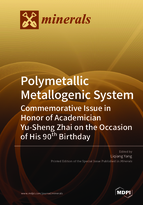Polymetallic Metallogenic System
A special issue of Minerals (ISSN 2075-163X). This special issue belongs to the section "Mineral Deposits".
Deadline for manuscript submissions: closed (15 January 2019) | Viewed by 118858
Special Issue Editor
Interests: orogenic gold; porphyry polymetal systems; water-rock reaction; mineral exploration; igneous petrology; structural geology in mineral deposit; ore-forming evolution
Special Issue Information
Dear Colleagues,
Within the last decade, the high and continuing demand for precious and base metals, as well as critical elements, has prompted a global rush on a scale never before seen. This eventually resulted in the demand for considerable innovation and improvement in mineral deposit genetic modelling and ore formation regimes for the many different types of gold deposits, now recognized, and paralleled by the wide employment of exploration techniques and a rapid expansion of geological databases.
This Special Issue will show case studies of porphyry polymetal systems, orogenic gold formations, water–rock reaction, ore-forming structure evolution, mineralogy and petrology of ore deposit, ore formation regime, geochronology and geochemistry of ore deposit, ore-forming evolution, mineral exploration and cutting-edge technology in ore deposit study.
We invite contributions on mineralogy, petrology, geochemistry, geochronology, and structure geology of ore-deposit formation and mineral exploration across all scales. Contributions from areas that integrate quantitative and qualitative techniques, including isotopic tracer and microanalysis, with field-based observations, as well as experimental analogues and theoretical models, are also welcomed.
Prof. Dr. Liqiang YangGuest Editor
Manuscript Submission Information
Manuscripts should be submitted online at www.mdpi.com by registering and logging in to this website. Once you are registered, click here to go to the submission form. Manuscripts can be submitted until the deadline. All submissions that pass pre-check are peer-reviewed. Accepted papers will be published continuously in the journal (as soon as accepted) and will be listed together on the special issue website. Research articles, review articles as well as short communications are invited. For planned papers, a title and short abstract (about 100 words) can be sent to the Editorial Office for announcement on this website.
Submitted manuscripts should not have been published previously, nor be under consideration for publication elsewhere (except conference proceedings papers). All manuscripts are thoroughly refereed through a single-blind peer-review process. A guide for authors and other relevant information for submission of manuscripts is available on the Instructions for Authors page. Minerals is an international peer-reviewed open access monthly journal published by MDPI.
Please visit the Instructions for Authors page before submitting a manuscript. The Article Processing Charge (APC) for publication in this open access journal is 2400 CHF (Swiss Francs). Submitted papers should be well formatted and use good English. Authors may use MDPI's English editing service prior to publication or during author revisions.
Keywords
- Porphyry polymetal systems
- Orogenic gold deposit
- Water-rock reaction
- Ore-forming structure evolution
- Mineralogy and petrology of ore deposit
- Ore formation regime
- Geochronology and geochemistry of ore deposit
- Ore-forming evolution
- Mineral exploration
- New technology in ore deposit study






